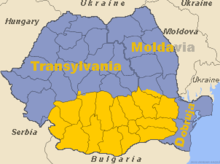 Foundation of Wallachia
Foundation of Wallachia
From Wikipedia, the free encyclopedia
Jump to:
navigation,
search

The
foundation of Wallachia (
Romanian:
Descălecatul Ţării Româneşti), that is the establishment of the first independent
Romanian principality, was achieved at the beginning of the 14th century, through the unification of smaller political units that had existed between the
Carpathian Mountains, and the Rivers
Danube,
Siret and
Milcov.
[1][2][3]
Prior to the consolidation of
Wallachia, waves of
nomadic peoples – the last of them being the
Cumans and the
Mongols – rode across the territory.
[4][5] The territory became a frontier area between the
Golden Horde (the westernmost part of the
Mongol Empire) and the
Kingdom of Hungary after 1242.
[6] The Romanians in
Muntenia, east of the
Olt River, had to pay tribute to the Mongols; and west of the river, in
Oltenia, they were oppressed by the
Bans of Severin, appointed by the
Kings of Hungary.
[7] The Golden Horde’s domination decreased in the region at the end of the 13th century, and at that time the Kingdom of Hungary also underwent a strong political crisis.
[8] These events enabled the incipient states of the territory to consolidate their autonomy.
[8]
One Romanian tradition records that Wallachia was founded when a certain
Radu Negru (‘Radu the Black’) arrived from the
Făgăraş region in the 1290s after crossing the
Transylvanian Alps with “a great many following him”.
[5][9] More credible is the report that some Romanian lords in the Olt and
Argeş valleys chose as leader one of their number, a certain
Basarab.
[5]
It was
Voivode Basarab I (c. 1310–1352) who broke off with the Kingdom of Hungary and refused to accept the king’s suzerainty.
[1] Basarab I received international support and the recognition of the autonomy of Wallachia due to
his great military victory over King
Charles I of Hungary (1301–1342) at Posada on November 12, 1330.
[1][10][11] The Metropolitan See of Wallachia, directly subordinated to the
Ecumenical Patriarchate of Constantinople, was set up during the reign of Basarab I’s son,
Nicolae Alexandru (1352–1364).
[12][13] The first silver and bronze coins were minted in Wallachia in 1365.
[14]

 →
→
 FlagCoat of arms
FlagCoat of arms














